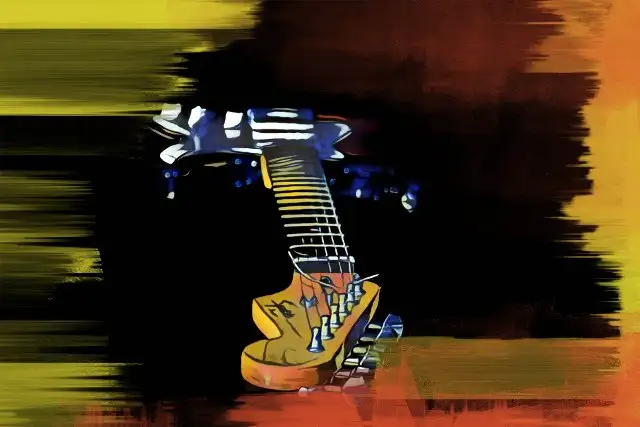Were there (m)any great guitar riffs before rock came about? How about great guitar riffs elsewhere, in other genres, contemporaries of rock? What is it that makes a guitar riff great? Is its popularity the most important factor?
A rock history aficionado and a huge fan of very many rock guitarists, this article's author does not want to displace rock guitar riffs from their naturally acquired iconic position. Yet, there are a lot of other things which need to be brought about and forward, regarding the greatest riffs of all time.
So, while retaining our connection to Van Halen, Led Zeppelin, Black Sabbath, The Rolling Stones, Deep Purple, AC DC and the rest of the field, we'll try to take a peek elsewhere as well, in an effort to give guitar playing - as a whole - a more complete insight.
What is a Guitar Riff?
A catchy guitar motif or phrase, repeated multiple times. The repeats provide a sort of anchor to the listener, while simultaneously bringing coherence and consistency to the overall musical form of the piece. Serving this purpose, most commonly the riffs are placed at the very opening.
At times, a certain catchy motif will occur only once, not necessarily composed or intended to be used as a riff. Sometimes such a motif will be a part of the lead guitar solo. Thus, one might wonder how important are the repeats; does a phrase's catchiness alone qualify it as a riff?
It's important to note that when we talk about a riff, we'd expect some sort of a repeating pattern, not necessarily to the letter, as looping software would. It can be rhythmic as well (as some of the riffs noted will show).
On the Topic of "Greatest Guitar Riffs"
There's always an ongoing debate on what brings what value, especially when talking in superlatives. For what's a great riff for one might sound insignificant to another. Hence, the guitar world might beg to differ from what will be presented below.
But then again: what is it that makes a guitar riff great? Is it's popularity all that matters? I'd say not really, cause then a previously iconic riff becoming less popular would mean that it is less great than it previously was, which - at the very least - is an absurd approach.
The Historical Context
Some of the best guitar riffs have been composed centuries ago. That said, we won't venture beyond what's applicable to the guitar as we know it: a 6-stringed instrument without string doublings. Hence, the earliest great classic riffs noted below are from the late 19th century.
Greatest Rock Guitar Riffs
Some electric guitar riffs are so popular, that playing them is considered "forbidden" in guitar stores. Apart from the ones we'll list as "greatest" below, these include the opening riff of "The White Stripes" of Seven Nation Army, Nirvana's "Smells Like Teen Spirit", "Sweet Home Alabama" of Lynyrd Skynyrd (to name but a few).
1) Stairway To Heaven – Jimmy Page
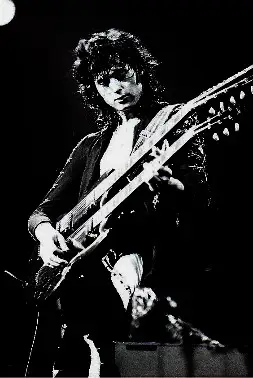
Yes; guitar store workers are sick of it.. for every David Bowie, or (say) Michael Jackson phrase played, they hear the riff from "Stairway to Heaven" tens (if not hundreds) of times. So, what is it that makes this guitar riff so popular; why is this song's popularity so high and is it due to the riff as such?
Contrary to the guitar riff being defined as something "...which focuses much of the energy and excitement..." (Rikky Rooksby), the riff from "Stairway to Heaven" is almost "flat" when it comes to these categories. Instead, it introduces a rather meditational ambience, immensely different from a standard classic riff.
An arpeggiated calm progression, slowly developing into a lyrical verse about "purchasing" an ascension to a higher realm of existence...
An exceptionally original package, based on an extraordinarily well composed guitar riff. Is there (even theoretically) anything more one could expect and get from their guitar riff?
2) Smoke On The Water – Ritchie Blackmore
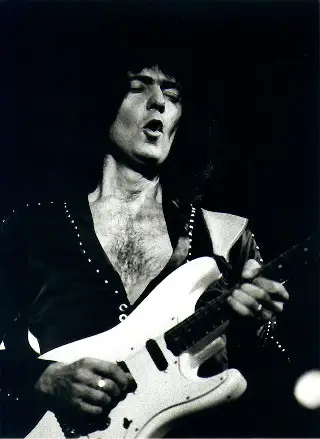
While also not on the list of favorite riffs of guitar salesmen, this riff certainly holds a place high up there in the heart of every electric guitar player. Moreover, one might say that the entire song is to rock history what "Billie Jean" of Michael Jackson is to pop music history. But why would this guitar riff be to rock what the bass riff of the ultimate pop song is to pop?
Searching for "Smoke On The Water" on Google returns "classic rock" as the song's genre. The Wikipedia article (the top article displayed by said search) on the other hand classifies the genre as "hard rock; heavy metal".
No common ground between the Google search and the article placed at it's very top is very, very rare. Of course, such an "effect" is maybe achievable if based on complexity, but seems impossible when based on simple means such as a guitar riff built of power chords only.
When you know what you're doing (i.e. when you are guitarist Ritchie Blackmore) - less is definitely more! And most of the best guitar riffs are exactly that: simple! Now, even easy guitar riffs sound heavy in heavy metal music, but that's a different topic altogether.
3) Sweet Child O' Mine – Slash
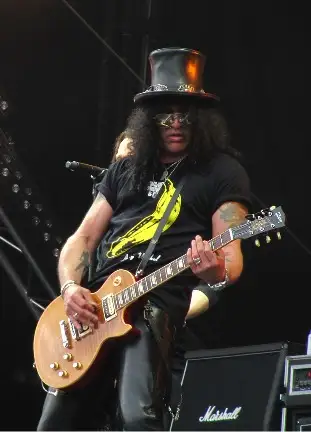
A smash hit, coming as a pinnacle of an era, soon after which most rock musicians seem to have said their definite goodbyes to the direct classic rock influences (and sometimes even references) in their music. It sounds almost unbelievable that this song is only 4 years older than the classic Nirvana "Smells like Teen Spirit".
In an interesting way, this guitar riff bears close resemblance to the best guitar riffs mentioned above. It's harmonically based on arpeggiated power chords, thus in an elegant way taking the "best of both worlds".
Slash flattened all the strings by a semitone, thus applying what's known as an alternative guitar tuning . It's difficult to tell whether it was done in order to assist Axl Rose's singing, or to make an otherwise light riff sound heavier.
One of the most popular songs ever, in a way marking the turning point toward heavy riffs in general anyway. Of course, light-sounding cheerful riffs continued to be composed, but have fallen out of fashion significantly during the late 80's and the early 90's.
a thought-provoking one-liner on rock
"Most of modern rock and roll is a product of guilt." - Captain Beefheart
Greatest Jazz Guitar Riffs
Improvisation - the most important building block of jazz - relies on original melodic ideas, which in turn inherit their coherency from rhythmic consistency. Thus, a jazzman speaking of "best guitar riffs" might actually be referring to rhythmic sequences, each one containing melodic and rhythmic variations on a previously played phrase. Literal riff repetitions are avoided.
1) BESAME MUCHO – WES MONTGOMERY
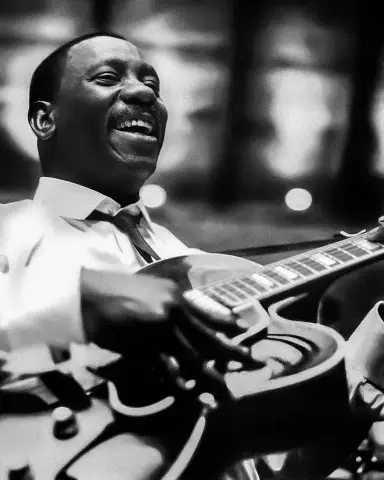
"Besame Mucho" is a bolero standard, an instant hit song released in 1940. As Montgomery was exiting his teens, he became very fond of this classic song, as it offered a different pulsation, compared to the standard 4/4 swing mood of most of the American music back then.
The guitar accompaniment of the song's original arrangement pulsates rather as (what will later be known as) Bossa Nova, stylistically very different from the well established Mariachi or the Bolero tradition.
Taking things a step further, the meter of "Besame Mucho" on Montgomery's "Boss Guitar" album is in 6/8. With the pulsation feel being less common, Wes went for an iconic riff at the opening of his solo.
The one-bar riff gets rhythmically repeated, with the melody adapted to the chord change, followed by 2 bars of both a melodic and rhythmically wide paraphrasing. As jazzmen do, he expanded on that in depth, but these first 4 bars of his solo are a true icon among the jazz guitar aficionados.
2) Django – Joe Pass
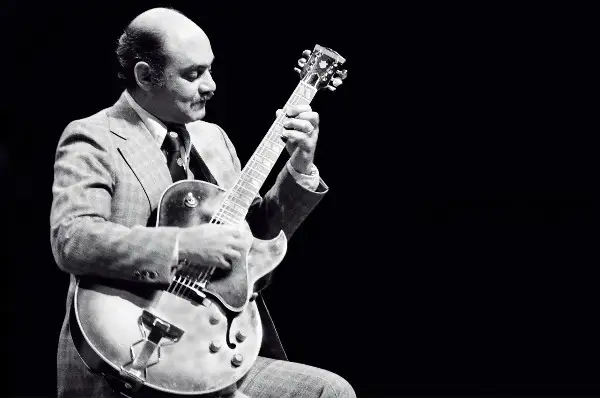
Though originally a standard tune in 4/4, the theme exposition of "Django" on the "For Django" album receives a completely original and unexpected metric solution. It's alternating between 3/4 and 4/4 for 10 bars, after which we hear 2 more bars in 4/4 with a short fermata at the end of the second one.
Eight bars of 3/4 close the theme, with a ritardando at the very end. Adding to the tune's quite unusual 20-bar form, this metric solution makes the whole song's sound almost otherworldly.
The theme itself is built upon a rhythmic riff, so Pass' solo on the "For Django" opens with a legendary response lick, as though to emphasize the return to the standard 4/4 medium swing tempo. This entire phrase is 4 bars long, containing 2 sub-riffs, of which the second one seems to have been borrowed from John Coltrane.
The main riff is presented in the 2nd bar of this solo opening, followed by said Coltrane riff for a bar and a half. Though the 3rd bar opens with further Coltrane exposition, it closes in the opposite direction, thus directionally completely coinciding with his own riff from bar 2. Sweet child of Pass!
3) MINOR SWING – DJANGO REINHARDT
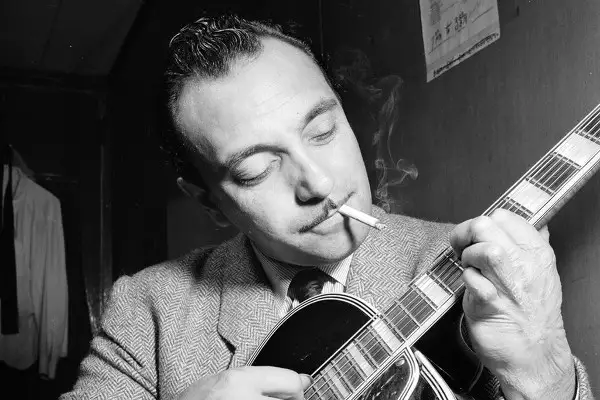
If the whole song consists of a single riff, that alone speaks volumes of the quality and originality of the riff. "Minor Swing" is built in such a fashion, having a simple 16-bar form.
While the theme is played without harmonic background, the solos have a standard I-IV-V-I progression in A-minor, where the subdominant chord surprisingly features its major 6th (normally considered an "avoid note").
An average guitar player might be tempted to rely only on the A-minor pentatonic scale for his entire solo, which would work of course. In fact, due to the subdominant D-minor chord having preserved its major 6th (B), even the E-minor pentatonic scale would work.
Django enters his solo with the riff clearly outlining the chords at hand. The riff starts with a stepwise motion, proceeding into a descending arpeggiated chord. A true trademark motion of his, and one of the best guitar riffs to have ever been produced indeed! The tune was recorded a total of six times, with this original riff from the 1937 take preserving its iconic status.
a thought-provoking one-liner on jazz
"If you have to ask what jazz is, you'll never know." - Louis Armstrong
Greatest Blues Guitar Riffs
In Blues, just like in jazz, it's common to have musicians perform famous songs of their predecessors or contemporaries. It is at times difficult to tell which riff was developed by whom, as song splits weren't a thing yet. The blues guitar riffs noted below are at the core of what defines and identifies a great blues riff anyway, regardless of who is to be credited.
1) Sweet Home Chicago – Robert Johnson
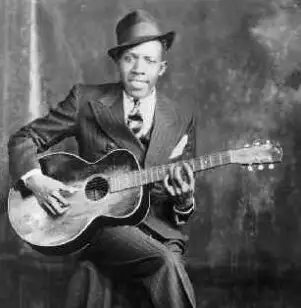
A true gem of almost mythical status, "Sweet Home Chicago" is considered by many as a blues hymn. And for a good reason: a blues live gig by any blues cover band almost certainly will have it as part of the set.
Johnson recorded the song for the first time in 1936. Though invented, stereo recording was still in its infancy, so only mono was on the "menu". In fact, even handling the white noise was still challenging really, as is evident on the recording.
The accompaniment on the guitar is based on a one-bar riff, where a block chord's top note ascends and descends alternately. Accents are on the downbeat, with the respective block chord repeated unaccented on the upbeat in a swing pulsation.
One asking of a simple guitar riff example which defines blues, would most likely be pointed to this riff. A riff defining a genre... what more can one say of its greatness.
2) Hoochie Coochie Man – Muddy Waters
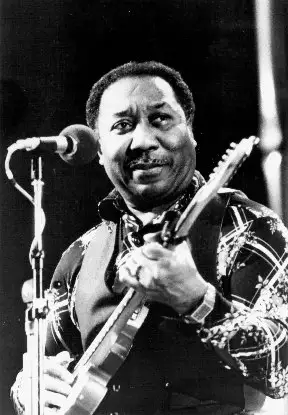
Hoochie Coochie Man was not a song Waters wrote, though he was the first to record it, back in 1954. It's interesting that he was already in his 40's then.
It seems that Waters was unmatched in his enthusiasm, which distinguished him from his peers. This is important, cause during the mid 1950's contemporary blues was at it's infancy, needing persistence and perseverance in order to be developed into a popular subgenre.
The riff itself is so powerful and dominant, that it's played interchangeably with the vocal. No guitar during the vocal lyrics, and no vocal during the riff. Interestingly, the riff consists of two melodic phrases with a similar rhythm, moving in opposite directions.
Countless blues songs written afterwards would follow a similar pattern, and thus this riff undoubtedly stands at the core of what defines contemporary blues.
3) Woke Up This Morning (My Baby's Gone) – b.b. king
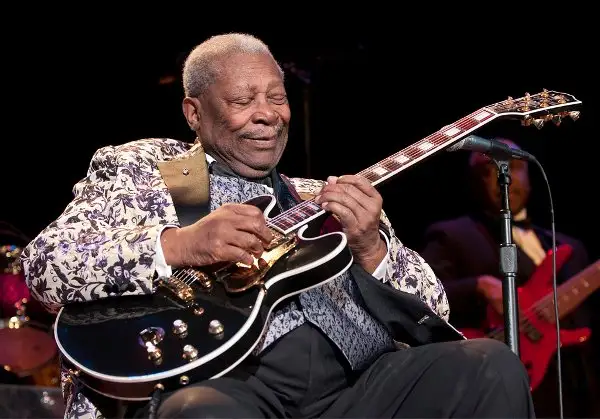
It can rightfully be said that a standard 12-bar blues form (with the standard harmonic progression preserved) remains a blues song, so long as other/foreign elements do not start dominating.
"Woke Up This Morning" is an archetypal example of a perfect balance. Obvious Latin and jazz influences, yet certainly still: a blues song.
The simple yet powerful riff could maybe be interpreted as coming from a different style, especially it's first appearance. Yet, as it's repeated, it contains melodic adaptations to the blues progression, thus clearly demonstrating it's blues character.
What defines a genre while not affecting (as in not overly dominating) the other included influences is indeed the most elegant solution. Both for the song and context at hand and the subgenre in general.
a thought-provoking one-liner on blues
"The blues was like that problem child that you may have had in the family" - B.B. King
Greatest Classical Guitar Riffs
From The Beatles' "Day Tripper", The Rolling Stones' "(I Can't Get No) Satisfaction" and Led Zeppelin's "Whole Lotta Love", through a significant portion of the opuses of Deep Purple, Black Sabbath, AC DC, Eric Clapton, Jimi Hendrix and Bob Marley, to David Bowie, Michael Jackson and even The White Stripes' "Seven Nation Army", an informed listener and classical music fan will detect the influences of the previous sentries.
Of course, no one in their right mind would claim that The Rolling Stones or AC DC are classical musicians, or that "Day Tripper", "Purple Haze", "Whole Lotta Love" and "Redemption Song" are of the classical music repertoire. Yet, as the influence is clearly attestable, one simple question arises: are there any classical guitar riffs which can be counted among the best guitar riffs of all time?
1) Recuerdos de la Alhambra – Francisco Tarrega

"Recuerdos de la Alhambra" is a perfect example of a piece inspired by history. A historical heritage sight, the Alhambra is a palace and fortress complex, located in Granada, Spain.
The piece completely relies on the riff heard at the very beginning. In it, the thumb plays arpeggiated chords throughout the piece, while the index, middle and ring fingers repeat the melody note in a sequence.
This riff's technique is known as "tremolo" (as compared to the electric guitar effect bearing the same name). Earlier tremolo examples are not known. A guitar riff defining a new technique? Pure awesomeness, at its finest!
Worth noting here, is that it turns out that the technique was introduced so as to compensate for the lack of sustain the guitar tone has. Nowadays one would just ramp up the compressor et voilà: job done.
2) Capricio Arabe – Francisco Tarrega
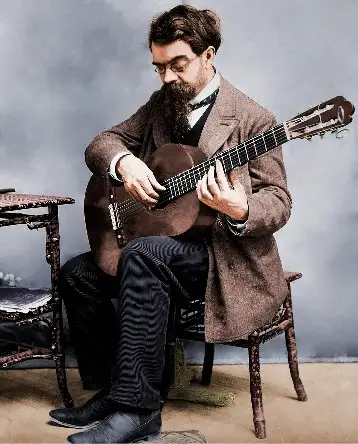
Some would say it's unfair to have a composer/guitarist featured more then once in a very short list. But if he is the main riff mag, would it not be unjust if he had to be limited to just one appearance?
A regular day tripper to the southern Spain, Tarrega would lead guitar enthusiasts to a closer acquaintance with Spain's history, feeling free to be inspired by the enormously rich and colorful heritage. Thus, he wrote his "Capricho Árabe" ("Arabian Capriccio"), once again paying homage to the tradition he was naturally very fond of, and at least partly inspired by.
The piece's main riff is introduced after the rubato-like intro, when the piece enters a steady medium tempo. As good riffs go, this guitar piece is almost entirely based on it, featuring some small rhythmic and melodic variations.
The sections not based on the riff serve only as transitions (i.e. riff connectors). As we've seen thus far, not only does the riff exist in classical music, but it's a piece's standard and most common corner-stone.
3) Asturias – Isaac Albeniz
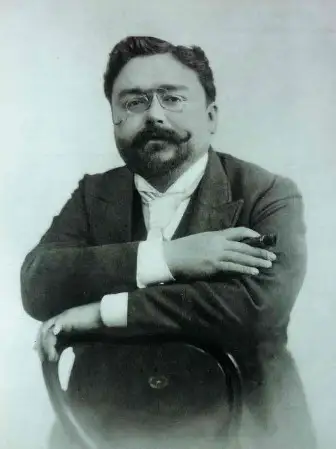
Imagine you wrote a piano piece, based on a short riff. Next, imagine someone adapted it for guitar. Finally, imagine the guitar version is more popular... like... 20 times more popular ( on YouTube anyway ). In such a situation, one might rightfully ask "isn't the piece's riff - for all practical intents and purposes - actually a guitar riff"?
It's understood that the piece's guitar adaptation used different chord voicings . Unlike any of the riffs mentioned thus far, this one quite explicitly requires finger style picking. This is because it's "spread" over non-neighboring strings, and the tempo is very fast.
The actual melody is placed in the lower register, and between two notes of the melody, a sustained high note is always played. This high note is rhythmically equally distanced from the melody notes that precede and succeed it. This riff flow is common on the flamenco guitar.
At the time when the piece was composed, flamenco guitar was not considered a solo instrument; even the classical guitar had to be "emancipated" still. Otherwise, it seems Albeniz will have written exclusively as a guitar composition. Thankfully, the natural flow of things had corrected this unintentional injustice.
a thought-provoking one-liner on classical music
"Everybody loves classical music; they just don't know about it yet." - Benjamin Zander
Greatest Folk Guitar Riffs
Bearing in mind that that folk music is - simply put - anything closely related to the musical traditions of a certain nation or a region, it is quite challenging to choose representatives among a field of vastly different musical traditions. One might say that there's also a huge difference between "Smoke on the Water" and "Johnny B Goode", or between "Ain’t Talkin’ ’bout Love" and any famous song of Eric Clapton. True. But how about the difference between a Balinese Gamelan and Country music, for example? Or between Mongolian throat singing and the Spanish flamenco singing?
"Folk" in this context, simply refers to clearly demonstrable authentic traditional ethnic musical influences (as opposed to being a coherent genre, with its own well-defined musical characteristics).
1) I walk the line – Johnny Cash
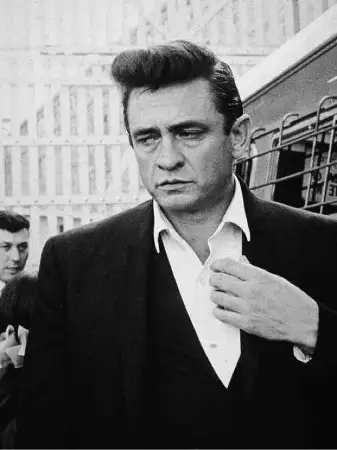
Apart from becoming an instant hit once recorded, the surprise of "I Walk the Line" is that it's transgenerational. It's cheerfulness and simplicity attracted the younger, it's obvious and very strong country music influence - the older generation.
It is definitely a country song, though some also consider it as rockabilly. If true, this only means that it was even more universally loved.
Defining the simple I-IV-I-V harmonic progression, the entire phrase consists of a one-bar melodic riff, repeated as transposed and adapted, to serve the melody and harmony. Very suitable for beginner guitar lessons.
Whilst the music world during the mid 1950's slowly started leaning toward dark chord progressions , simple guitar riffs still stood the test of time. A richness made out of few resources.
2) Cancion del Mariachi – Antonio banderas
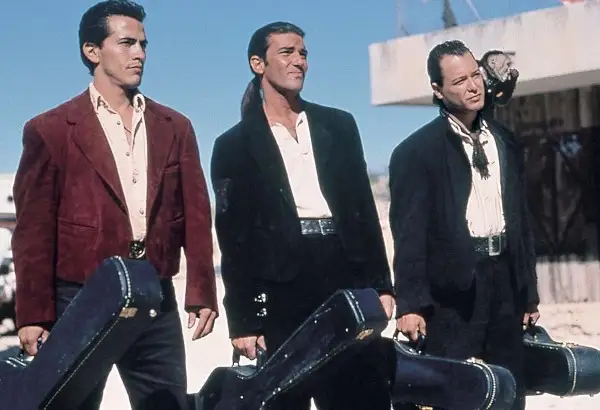
Featured in the film "Desperado", the song is a mid 90's classic (just as the film itself is). Was the film made popular because of its music, or did it popularize the music featured in it? Hard to tell.
This song however, almost 30 years after the film's release, is still a go-to song when the contemporary Mariachi style needs to be presented. One thing is for sure: Antonio Banderas actually does play the lead guitar on the recording, surprising many at the time.
Placed at the beginning of the song , the riff enters alone (the version in the film features a rubato intro which precedes it, though). An arpeggiated triad defines the harmony, moving into parallel thirds, announcing the riff's melody. The bend then enters, playing a pretty typical Mariachi accompaniment in 3/4.
An exceptionally universal riff. It fits perfectly within the Mariachi musical idiom, yet one can think of a plethora of band entrances which could describe vastly different styles and genres. Yet, with all of them - the riff would work perfectly! Universality at its finest!
3) Entre dos Aguas – Paco de lucia
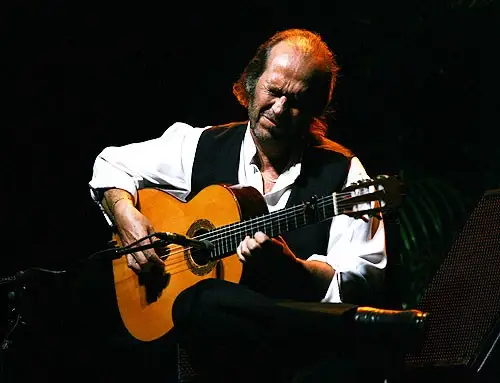
"Entre Dos Aguas" would not even have been written, had Paco had enough songs/compositions for his album "Fuente y Caudal" . Lacking one tune, he thought of the riff ad hoc, sung it to his bandmates and walked into the studio.
The theme was very successful even as a single, bringing up the sales of the album itself. This was surprising, as a flamenco album dominated by a flamenco-rumba composition (with rumba itself having been imported a few generations ago from South America), was sort of a contradiction in terms.
Interestingly, what precedes the guitar riff is a bass riff which enters alone at the very beginning. The guitar riff enters only after the entrance of the percussion and the the rhythm guitars.
A short one-bar riff and two chords is sometimes all that's needed. Of course, Paco's virtuosity produces wonders building upon it, yet the riff is the corner stone, the inspiration, the wonder's soul!
a thought-provoking one-liner on folk music
"Folk music is a bunch of fat people" - Bob Dylan
Honorable Mentions, Comments and Some Additional Points
"The Jimi Hendrix Experience" features a ton of epic guitar riffs, with the crowd's favorite probably being the opening riff from "Purple Haze". Furthermore, most of the riffs of the ever inspiring bands and/or instrumentalists already mentioned (Deep Purple, Rolling Stones, Eric Clapton, Eddie Van Halen and a bunch of others) undoubtedly stand among the finest riffs of the entire guitar history.
Famous guitar riffs are famous for a reason and that's all fine and well. Sounding punk-like or like "Ain't Talkin' 'bout Love" of Eddie Van Halen, or like Bob Marley's "Redemption Song" a good original song relies primarily on a lovable riff.
Easy guitar riffs are not always the best solution, though simplicity ought to always be sought after. For as important as they are, riffs alone are not the whole story. How about the harmony? Is it complex or it consists of just two chords? The rhythm, the tempo, the band members... everything matters!
Conclusion
This article's aim was to make an effort at bringing forward some lesser-known riffs, coming from less popular genres to the attention of the guitar aficionados. Even beginner guitarists at times can compose fantastic riffs, and so keeping them informed can only be of help. After all, today's kids are the Deep Purple and Led Zeppelin of tomorrow, playing the lead guitar, composing the next "Smoke on the Water", climbing the "Stairway to Heaven".
Finally, at times all that's needed is - time! And if your original song slowly becomes more and more featured in different people's video lessons, remote or in-person guitar lessons, I'd venture to say that it being mentioned in the Rolling Stone magazine is just a matter of time. With patience, even the sky is not the limit; it's not even the beginning of the limit. But it can - and should - mark the end of a stellar beginning!


